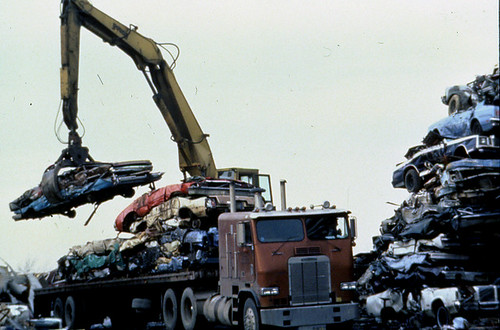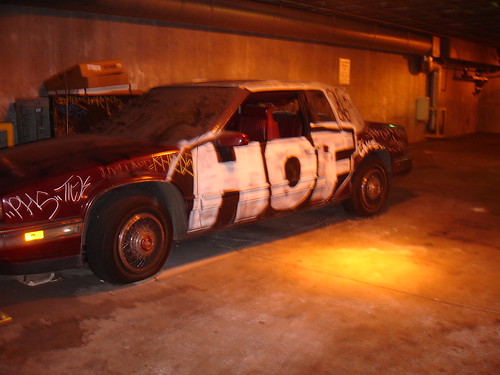(Source: USA Today & Image: Jalopnik)

As the American lawmakers are getting ready to pass the landmark “cash for clunkers” legislation, many of you are still left wondering what this legislation entails and how it will affect you. The media chatter in the past has offered very little except that the legislation would provide federal vouchers of up to $4,500 for people to trade in their older vehicles for new ones that get better mileage.
Talk of the vouchers has kept some would-be new car and truck buyers on the sidelines, waiting to see whether they’d qualify for government help. So, for the moment, the idea is hurting sales. Based on interviews with lobbyists and congressional offices, the USA Today captured the details of this legislation in a nice Q & A format:

Image: Newsday
Q: What’s the idea behind “cash-for-clunkers”?
A: Supporters say it would replace older vehicles with new ones that use less fuel, are safer and pollute less. And it would give the struggling auto industry a sales boost.
Q: What’s the bill’s status?
A: It’s in a House committee and backed by the president. Senators from both parties are prepared to co-sponsor similar legislation as soon as this week.
Q: Sounds like a sure thing.
A: Not so. Environmental lobbyists, who don’t think it boosts fuel economy enough, might derail it or get it changed enough in the Senate that a compromise would take awhile.
Q: Any groups trying to keep it from being derailed?
A: You bet. Car companies, autoworkers, component suppliers and car dealers, among them. The House bill “will help jump-start auto sales and the U.S. economy, while also providing environmental benefits and increasing energy security,” says Ziad Ojakli, Ford Motor spokesman.
Q: What’s the price tag?
A: About $4 billion. The money is currently proposed to come from Energy Department funding included in the already enacted $787 billion economic stimulus package.
Q: If the House bill becomes law, how would it work?
A: The government would send up to $4,500 to the selling dealer on your behalf, if you:
1. Trade in a car that — this is a key point — has been registered and in use for at least a year, and has a federal combined city/highway fuel-economy rating of 18 or fewer miles per gallon.
2. Buy a new car, priced at $45,000 or less and rated at least 4 mpg better than the old one (gets a $3,500 voucher). If the new one gets at least 10 mpg better, you get the full $4,500.
Example: Trade that well-worn 1985 Chevrolet Impala V-8, rated 14 mpg, for a 2009 Impala V-8 rated 19 mpg and the government will kick in $3,500. Downsize to Chevy Cobalt (27 mpg) or even a larger Honda Accord (24 mpg) and get $4,500.
Mileage ratings back to 1985 are at www.fueleconomy.gov.
Q: What about trucks?
A: It’s more complicated.
For standard-duty models — most SUVs, vans and pickups:
1. The old one must be rated 18 mpg or less.
2. The new one must be at least 2 mpg better for $3,500 or at least 5 mpg better for $4,500.
For heavy-duties (6,000 to 8,500 pounds gross vehicle weight rating):
1. The old one must be rated 15 mpg or less.
2. The new one must be rated at least 1 mpg better for $3,500, or 2 mpg or more for $4,500.
Work trucks (8,500 to 10,000 lbs.) don’t have mpg ratings, so age is the criteria. The old one has to be a 2001 model or older. And only $3,500 is available.
Q: Is it worth it for $4,500?
A: The assumption is that the people most likely to use the program would trade in cars worth less than $4,500. Thus, while not necessarily clunkers, most would be at least 8 years old.
Q: Can I combine these incentives with other offers?
A: Yes. For instance, you could trade for a hybrid and get the voucher, claim the hybrid tax credit and get dealer or manufacturer discounts. You also could deduct the sales tax, if any, on your next federal tax return.
Q: Would I ever see the $3,500 or $4,500?
A: No. It’s an electronic transfer from the government to the dealer. Dealers want to be sure the amount can be counted as cash from the buyer, which would help buyers get credit because they’re financing less.
Q: What does the dealer do with my trade-in?
A: Gives it to a salvage operator. The engine, transmission and some other parts must be destroyed so they can’t be reused. The idea is to cull fuel-thirsty, polluting drivetrains. Operators can resell other parts, however.
Q: What’s to keep me from buying a junkyard car for a few hundred bucks, getting it barely running and trading it?
A: The one-year-in-service requirement noted earlier. Lawmakers wanted to exclude the revival of so-called junkyard dogs, because they’ve already been taken off the road.
Q: What do I get if I recently bought a car that would have qualified?
A: The bill contemplates making the incentives retroactive to March 30, but it’s unclear how to find and junk cars that were traded in that long ago. Some might already be back on the road, driven by new owners.
Q: What’s wrong with environmentalists’ idea that the new car or truck should get much better fuel economy than the House bill currently requires?
A: Opponents say the environmentalists’ fuel-economy improvement thresholds are so high that foreign brands benefit disproportionately, because their lineups tend now to have more small, fuel-efficient vehicles.
But the American Council for an Energy-Efficient Economy complained in a statement criticizing the House bill that the proposal as it stands now is way too lenient.
The council charged that the bill “aims primarily to clear Detroit’s unsold inventory from the storage lots,” rather than to seriously cut fuel use.
Q: How soon could this become law?
A: Depends on how much critics can sway the Senate, and to what piece of legislation this “fleet modernization” bill is attached.
If it becomes part of a larger bill that’s likely to get lots of debate, it could take awhile. If it’s attached to urgent, must-pass legislation, such as an appropriation bill, it could move quickly to the president’s desk.
A current plan is to add the program as an amendment to climate change legislation now being considered.
As proposed, it would be in effect for just one year.
 At a recycling plant in San Pedro and five other similar operations around California, giant shredding machines annually reduce 1.3 million junk cars, refrigerators and other appliances into fist-sized chunks of metal.
At a recycling plant in San Pedro and five other similar operations around California, giant shredding machines annually reduce 1.3 million junk cars, refrigerators and other appliances into fist-sized chunks of metal.









 May 7, 2009-The National Hydrogen Association (NHA) and U.S. Fuel Cell Council (USFCC) issued the following joint statement regarding the Obama Administration’s FY 2010 budget request for the U.S Department of Energy:
May 7, 2009-The National Hydrogen Association (NHA) and U.S. Fuel Cell Council (USFCC) issued the following joint statement regarding the Obama Administration’s FY 2010 budget request for the U.S Department of Energy: